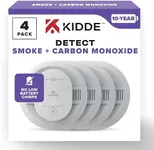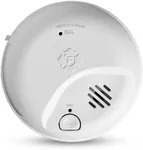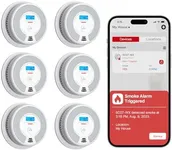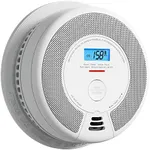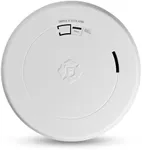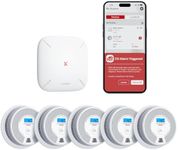Buying Guide for the Best Smoke Detector Carbon Monoxide Detectors Combo
Choosing the right smoke and carbon monoxide detector combo is crucial for ensuring the safety of your home and loved ones. These devices are designed to detect the presence of smoke and carbon monoxide, alerting you to potential fire hazards and dangerous gas leaks. When selecting a combo detector, it's important to consider several key specifications to ensure you get the best fit for your needs. Understanding these specifications will help you make an informed decision and provide peace of mind knowing that your home is protected.Sensor TypeThe sensor type in a smoke and carbon monoxide detector determines how it detects smoke and CO. Common types include ionization sensors, which are better at detecting fast-flaming fires, and photoelectric sensors, which are more responsive to smoldering fires. Some models combine both types for comprehensive coverage. For carbon monoxide detection, electrochemical sensors are the most reliable. Choose a combo detector with both photoelectric and electrochemical sensors for the best protection against both fire and CO hazards.
Power SourceThe power source for a smoke and carbon monoxide detector can be either battery-operated, hardwired, or a combination of both. Battery-operated models are easy to install and can be placed anywhere, but require regular battery replacement. Hardwired models are connected to your home's electrical system and often have battery backup for power outages. Combination models offer the reliability of hardwiring with the convenience of battery backup. Consider your home's setup and your preference for maintenance when choosing the power source.
InterconnectivityInterconnectivity refers to the ability of multiple detectors to communicate with each other. When one detector senses danger, interconnected units will all sound an alarm, providing a more comprehensive alert system. This feature is especially important in larger homes or multi-story buildings. Some models offer wireless interconnectivity, which is easier to install, while others require hardwiring. If you have a large home or want to ensure maximum coverage, look for detectors with interconnectivity.
Alarm TypeThe alarm type in a smoke and carbon monoxide detector can vary, with some models offering voice alerts in addition to traditional sirens. Voice alerts can provide specific information about the type and location of the danger, which can be particularly helpful in an emergency. Traditional sirens are loud and effective but may not convey as much information. Consider whether you prefer a simple siren or the added clarity of voice alerts when choosing your detector.
Lifespan and MaintenanceThe lifespan of a smoke and carbon monoxide detector is an important consideration, as sensors degrade over time. Most detectors have a lifespan of 7-10 years, after which they should be replaced. Some models come with end-of-life indicators to remind you when it's time for a replacement. Regular maintenance, such as testing the alarm and replacing batteries, is also crucial for ensuring the detector functions properly. Look for models with easy maintenance features and clear lifespan indicators to keep your home safe.
Additional FeaturesAdditional features in smoke and carbon monoxide detectors can enhance their functionality and convenience. Some models offer smart connectivity, allowing you to monitor and control the detector via a smartphone app. Others may include features like emergency lighting, which can help illuminate your escape route in the event of an alarm. Consider what additional features might be beneficial for your home and lifestyle when selecting a detector.
